Circuit Concepts - Complete Toolkit
Objectives
- To recognize current as the rate of charge flow and to distinguish it from drift speed.
- To identify the conditions which must be met in order for electric current to be established in a circuit.
- To describe the role of the battery in an electric circuit and to relate the voltage rating of the battery to the change in electric potential energy per unit of charge.
- To describe electric power as the rate of energy consumption by a circuit element and to use the various power equations to calculate the power of a circuit element.
- To identify the voltage-current-resistance relationship and to use the relationship to solve simple computational problems.
- To relate the cost of using an electrical appliance for a given amount of time to circuit quantities such as voltage, current, power, and resistance.
Readings from The Physics Classroom Tutorial
- The Physics Classroom Tutorial, Current Electricity Chapter, Lesson 1
- The Physics Classroom Tutorial, Current Electricity Chapter, Lesson 2
- The Physics Classroom Tutorial, Current Electricity Chapter, Lesson 3
Interactive Simulations
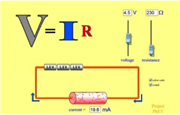 PhET Simulation: Ohm’s Law
PhET Simulation: Ohm’s Law
This interactive model provides a look at how Ohm’s Law pertains to a series circuit. Change the voltage and observe the effect on resistance and current through the circuit. Change the resistance to see the resulting changes in battery voltage and current. This model is a good choice for beginners who have completed a first hands-on lab on electric circuits. It was developed to help students visualize the mathematical relationships presented in Ohm’s Law.
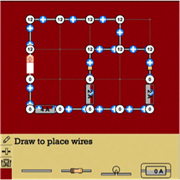 The Physics Classroom: Circuit Builder
The Physics Classroom: Circuit Builder
This interactive simulation from The Physics Classroom's Physics Interactive section provides students with a virtual circuit building kit to build and explore circuit concepts. Students simply drag wires, resistors, light bulbs, and ammeters onto the screen and arrange them in any order they wish. Once a complete circuit is obtained, charges are shown flowing through the wires and measurements of current and electric potential can be made. The Interactive is accompanied by a classroom-ready exercise that is designed to discover Ohms Law through a systematic alteration of variables. The exercise concludes with students using the Claim-Evidence-Reasoning approach of making and supporting conclusions.
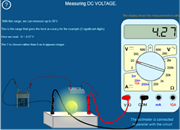 Tesla Institute: Multimeter Simulation
Tesla Institute: Multimeter Simulation
Multimeters aren’t cheap and they take some getting used to. Why not let your students interact with a multimeter simulation to get a better feel for using the device correctly, reading measurements accurately, and learning some basic safety without risk? This free simulation was created by the Tesla Institute.
 Harvard University: Action Potential in an Axon
Harvard University: Action Potential in an Axon
This beautifully-animated tutorial takes a deep look inside a neuron to explore how electrical impulses (signals) are transported along an axon to create an “action potential” allowing our nerve cells to talk to each other. Explore how sodium and potassium ions move across an axon membrane to produce the charge imbalance necessary for electrical signals to propagate. Students are given “missions” to place the ions in proper position and open/close channel gates to create an action potential or restore polarization. Great way to integrate Biology and Physics!
 Concord Consortium: Electric Current Model
Concord Consortium: Electric Current Model
Take a deep exploration into the relationships between voltage, current, and resistance with this set of interactive models for introductory physics. It starts with atomic-level models to investigate how voltage and resistance affect electron flow. Then it explores how current is different from voltage and finishes with models of a hydrogen fuel cell and an incandescent light bulb filament. Students can take snapshots of their models, annotate them, and save or share. Allow 90 minutes.
Video and Animations
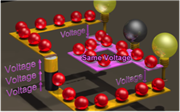 Physics Videos: Basics of Voltage and Current Laws
Physics Videos: Basics of Voltage and Current Laws
If your students don’t quite get potential difference, they will after watching this video by electrical engineer Eugene Khutoryansky. It can be hard to understand how voltage is related to potential energy. It can be harder to understand that it’s the difference in voltage that determines the amount of current. The video is nicely animated, with both text and narration to meet different learner needs. The author also includes explanations of Kirchoff’s Voltage Law and Current Law.
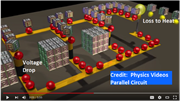 Physics Videos: Battery Energy and Power
Physics Videos: Battery Energy and Power
This 3D video was developed to strengthen conceptual understanding of how charged particles flow in a very simple circuit that includes a battery, wire, and a lightbulb. The author compares potential energy to boxes (see screenshot) attached to the charged particles. It shows the role of the battery in pushing charged particles to higher potential. When the particles flow through the light bulb, the electric potential energy is converted into light and heat, resulting in electric potential difference (voltage drop). Finally, the particle movement is animated for both parallel and series circuits, which perform very differently. Note: This resource specifically addresses a common misconception among students that the battery is the source of charge (see “Misconceptions” section below).
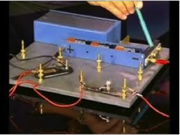 Education Commons: Electric Current
Education Commons: Electric Current
Possibility for a flipped lesson, this 14-minute video uses circuit board demos and animated circuit diagrams to explain what happens when current flows through two light bulbs in a circuit. Explicit explanations of why the current flow is greater in one of the bulbs in the series should help dispel the misconception that “the current is used up”. Good choice for students with disabilities, English Language Learners, or struggling readers.
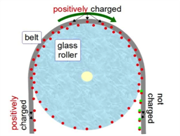 How a Van de Graaff Generator Works
How a Van de Graaff Generator Works
This animated video takes a deep dive into the Van de Graaff generator, down to the movement of protons and electrons. The narrator explains that the generator works because the two rollers and the belt that circulates between them are made of different materials. As the roller comes into contact with, and is pulled apart from the rotating belt, a charge imbalance arises that facilitates the rest of the interaction. Teachers: For Conceptual Physics classes, we recommend stopping the video at about 8 minutes. Students in AP or advanced classes may appreciate the background in the Tribolectric Series, Faraday Ice Pail effect, and the photoelectric effect.
An AAPT Cross-Curricular Activity
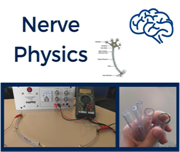 Nerve Science: Explore How Neurons Work
Nerve Science: Explore How Neurons Work
This free resource was developed in 2016 by the American Association of Physics Teachers to engage students through a hands-on lab that integrates physics and biology. Students model signal transmission along an axon by sending a small electric current through a vinyl tube filled with salted gelatin. The lesson plan was inspired by “Bridging Physics and Biology Using Resistance and Axons”, an article in The Physics Teacher journal. It’s intended to provide a meaningful, real-world context for students to investigate electric current, factors affecting resistance, electric potential difference, and how electric signals are conducted through human nerve cells. Materials are readily obtainable; you will need a power source and voltmeter or multimeter.
Labs and Investigations
- The Physics Classroom, The Laboratory, Sparky the Electrician Lab
Students use a cell, wire and bulb to identify four different arrangements that lead to a lit bulb and use findings to make generalizations about what is required to have a circuit.
- The Physics Classroom, The Laboratory, First to Light Lab
Students make observations regarding lighting times for the individual bulbs in a two-bulb or three-bulb circuit.
- The Physics Classroom, The Laboratory, Voltage-Current-Resistance Lab
Students conduct a controlled experiment to determine the mathematical equation relating battery voltage, current, and resistance for a simple circuit.
- The Physics Classroom, The Laboratory, Round vs. Oblong - the Greatest Resistance? Lab
Students investigate the resistance of two different types of bulbs by placing them in two separate circuits with a control bulb.
- The Physics Classroom, The Laboratory, Greatest Current Lab
Students use a magnetic compass placed below a wire to investigate the relative current in various wires of a two- or three-bulb circuit.
Link:
http://www.physicsclassroom.com/lab/circuits/Clabs.html
Electrical Safety in the Lab
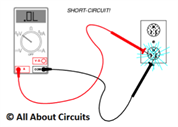 All About Circuits: Electrical Safety
All About Circuits: Electrical Safety
This excerpt from the All About Circuits textbook provides comprehensive background on common sources of hazard in working with electrical devices. The greatest hazards for the circuit lab occur when devices are handled with wet skin and when students lack a firm understanding of safe operation of devices. One full page is devoted to safe usage of the multimeter.
- Maryland State Department of Education: Physics Lab Safety
One problem in maintaining safe school lab environments is that there is no standardized lab safety protocol that crosses all 50 states. This article was written to alert physics teachers to potential dangers in activities frequently performed in the high school physics classroom. See Page 2 of the article for the section on electrical hazards.
Demonstration Ideas
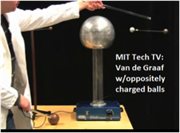 MIT Tech TV: Inducing Dipoles with a Van de Graaff Generator
MIT Tech TV: Inducing Dipoles with a Van de Graaff Generator
This is one of the cooler videos we’ve seen! This short video from MIT promotes understanding of how a dipole is formed in the field of a Van de Graaff generator. The generator is negatively charged. When two oppositely-charged conducting balls are brought nearby (photo at left) the generator induces a positive charge on the close silver ball. The dipole will always align itself with the electric field. Now here’s some fun: MIT set up a system of three bells – the outer bells connected by a conducting rod and the inner bell is grounded (photo at right). Small metal balls are hung between each bell. The small balls are attracted to the outer bells, but the grounded inner bell causes an interaction within the electric field of the Van de Graaff generator -- and the bells ring.
 MIT Tech TV: Conducting Glass
MIT Tech TV: Conducting Glass
Want a cool discrepant event? By high school, most students have learned that certain materials like metals are good conductors of electricity while other materials (like glass) are good insulators and inhibit the free flow of charge. But did you know that if you heat glass enough, it can become an ionic conductor – a solid that conducts electricity by the passage of ions. Ionic conduction is one mechanism of current.
- MIT Tech TV: Temperature Effect on Resistance
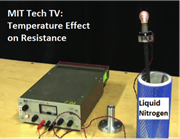
We’re betting that your students are familiar with 3 factors that influence resistance in a conductor: the conductivity of the material, cross-sectional area, and length of the conductor. The fourth factor, temperature, seems to be less obvious to students because it it’s not as simple to test in the classroom. Generally, the higher the temperature, the higher the resistance. But at extremely low temperatures (see photo above), the resistance decreases, causing current to increase and the bulb to glow.
Minds On Physics Internet Modules:
The Minds On Physics Internet Modules are a collection of interactive questioning modules that target a student’s conceptual understanding. Each question is accompanied by detailed help that addresses the various components of the question.
- Electric Circuits, Ass’t EC1 - Current
- Electric Circuits, Ass’t EC2 - Voltage
- Electric Circuits, Ass’t EC3 - Voltage, Power, and Energy
- Electric Circuits, Ass’t EC4 - Resistance, Voltage and Current
- Electric Circuits, Ass’t EC5 - Voltage, Resistance and Current Calculations
- Electric Circuits, Ass’t EC6 - P, I, V, R, and Cost Calculations
Concept Building Exercises:
- The Curriculum Corner, Electric Circuits, Electric Potential Difference
- The Curriculum Corner, Electric Circuits, Electric Circuits and Electric Current
- The Curriculum Corner, Electric Circuits, Electrical Resistance
- The Curriculum Corner, Electric Circuits, Electrical Power and Energy
- The Curriculum Corner, Electric Circuits, Mathematical Relationships in Circuits
Problem-Solving Exercises:
- The Calculator Pad, Electric Circuits, Problems #1 - #19
Link: The Calculator Pad
Science Reasoning Activities:
- Bulb A vs. Bulb B
- Wire Gauge Characteristics
Link: Science Reasoning Center
Real Life Connections:
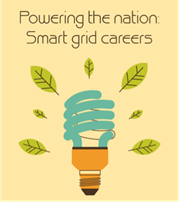 Bureau of Labor Statistics: Smart Grid Careers
Bureau of Labor Statistics: Smart Grid Careers
Here’s a compelling reason to get kids engaged in learning deeply about electricity: the United States is embarking on a modernization of our old power grid and this effort will provide a plethora of jobs in smart grid technology. This 12-page article (released in 2013) describes career fields related to the Smart Grid. While many of the new jobs will be filled by engineers, architects, and computer analysts, a variety of positions will not require an advanced degree. And you’ll be surprised at the high average wage for graduates with Bachelor’s degrees and 2-year certifications.
 Department of Energy: What is the Smart Grid?
Department of Energy: What is the Smart Grid?
Nicely-organized package of materials that explains the need for modernization of our electrical power grid system, what makes grid “smart”, and what a Smart Grid does.
View Smart Grid Infographic
Common Misconception:
- The Battery as the Source of Charge
Perhaps the most vicious misconception of a circuits unit is the false belief that the battery is the source of charge in the circuits. Students conceive of a circuit working because the battery supplies charge that moves at very high speeds from the battery through the wires to the various circuit elements to cause them to work. Holding this misconceptions, students further believe that the resistors use up or consume the charge such that the amount that exits the resistor is less than the amount that enters it. The misconception continues to wreak havoc as students adhere to the belief that when the circuit does not work, the battery is all out of charge and must be re-charged. Of course this line of reasoning is rather logical but it unfortunately begins with a false belief - that batteries supply the charge that is moving in the circuit. In combatting this misconceptions, it is helpful to demystify "charge" by explaining that the mobile charge carrier in the wires of the circuit are mobile electrons. Students will readily agree that the electrons are present in the atoms of the conducting material and can readily move through the material if an electric potential difference is impressed across it. As such, the role of the battery is to provide the energy required to establish this difference in potential across the two ends of the circuit and thus cause the charge that is already present to begin its flow.
- Current versus Drift Speed
Current and speed are two often-confused quantities and it is important that instructors take every pre-caution to avoid reinforcing the confusion. Current is the rate at which charges pass a point on the circuit; it has nothing to do with the distance that the charges are moving. Speed refers to how fast those charges are moving; this refers to the distance traveled per unit of time. It is important to avoid using the term "fast" to describe charges in a circuit with a high current. High current is due to a large quantity of charges crossing an imaginary point in a circuit in a second; they do not have to move far during this second. There only needs to be a lot of charges crossing the point.
Elsewhere on the Web:
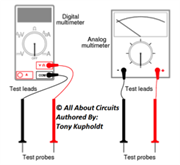 All About Circuits: Basic Concepts & Test Equipment
All About Circuits: Basic Concepts & Test Equipment
This chapter from the free digital textbook All About Circuits, provides simple experimental procedures for introducing the voltmeter, ammeter, and Ohmmeter in the introductory classroom.
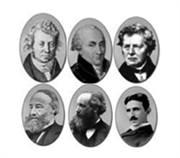 Molecular Expressions: Pioneers in Electricity and Magnetism
Molecular Expressions: Pioneers in Electricity and Magnetism
Comprehensive collection of biographies that celebrate the pioneers of electricity and magnetism, including notable names such as Ampere, Galvani, Coulomb, Fermi, Feynman, Fleming, Gauss, Hertz, Joule, Lord Kelvin, Maxwell, Oersted, Ohm, Tesla, and Volta. You’ll also find more than 20 bios of less well-known, but highly influential pioneers in the field.
Standards:
A. Next Generation Science Standards (NGSS)
Disciplinary Core Ideas – Physical Science
- Middle School: Forces and Interactions – MS.PS2.B.1 Electric and magnetic (electromagnetic) forces can be attractive or repulsive, and their sizes depend on the magnitudes of the charges, currents, or magnetic strengths involved and on the distances between the interacting objects.
- High School: Structure of Matter – HS-PS1.A.1 The structure and interactions of matter at the bulk scale are determined by electrical forces within and between atoms.
- High School: Definitions of Energy – HS-PS3.A.4 “Electrical energy” may mean energy stored in a battery or energy transmitted by electric currents.
- High School: Energy Conservation -- HS-PS3.D.1 Although energy cannot be destroyed, it can be converted to less useful forms—for example, to thermal energy in the surrounding environment.
Performance Expectations
- High School – HS-PS2-6 Communicate scientific and technical information about why the molecular-level structure is important in the functioning of designed materials or systems.
- High School – HS-PS3-2 – Develop and use models to illustrate that energy at the macroscopic scale can be accounted for as a combination of energy associated with the motions of particles and energy associated with the relative positions of particles.
Crosscutting Concepts
- Crosscutting Concept #2: Cause & Effect: Mechanism and Explanation – Events have causes, sometimes simple, sometimes multifaceted. A major activity of science is investigating and explaining causal relationships and the mechanisms by which they are mediated.
- Crosscutting Concept #4: Systems and System Models – Defining the system under study (specifying its boundaries and making explicit a model of that system) provides tools for understanding and testing ideas that are applicable through science and engineering.
- Crosscutting Concept #5: Structure and Function – Structures can be designed to serve particular functions by taking into account properties of different materials, and how materials can be shaped and used.
Science and Engineering Practices
Developing and Using Models: High School
- Develop and/or use multiple types of models to provide mechanistic accounts of phenomena
- Develop and/or use a computational model to generate data to support explanations, predict phenomena, and analyze systems.
Planning and Carrying Out Investigations: High School
- Plan and conduct an investigation individually and collaboratively to produce data to serve as the basis for evidence…..and consider limitations on the precision of the data
- Collect data about a complex model or system to identify failure points or improve performance relative to criteria for success or other variables.
Analyzing and Interpreting Data: High School
- Analyze data using tools, technologies, and/or models to make valid and reliable scientific claims or determine an optimal design solution.
- Analyze data to identify design features or characteristics of the components of a proposed system to optimize it relative to criteria for success.
Engaging in Argument from Evidence: High School
- Make and defend a claim based on evidence about the natural world that reflects scientific knowledge and student-generated evidence.
Using Mathematics and Computational Thinking: High School
- Create and/or revise a computational model or simulation of a phenomenon, designed device, process, or system.
- Use mathematical and/or algorithmic representations of phenomena or design solutions to describe and/or support claims and explanations.
- Apply techniques of algebra and functions to represent and solve scientific and engineering problems.
Constructing Explanations: High School
- Construct and revise an explanation based on valid and reliable evidence obtained from a variety of sources (including students’ own investigations, models, theories, simulations) and the assumption that theories and laws that describe the natural world operate today as they did in the past and will continue to do so in the future.
Obtaining, Evaluating, and Communicating Information: High School
- Critically read scientific literature adapted for classroom use to determine the central ideas or conclusions and/or to obtain scientific and/or technical information to summarize complex evidence, concepts, processes, or information presented in a text.
- Gather, read, and evaluate scientific and/or technical information from multiple authoritative texts.